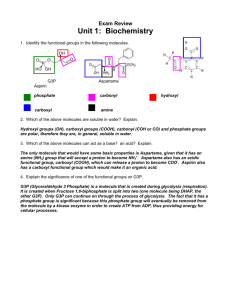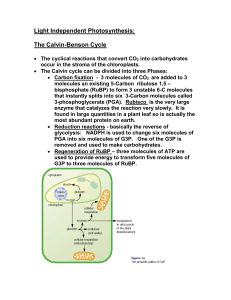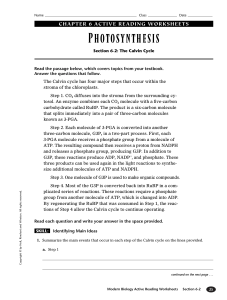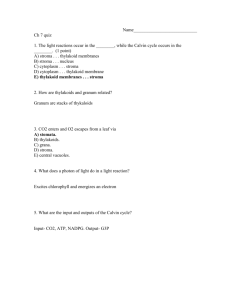HOMOGENIZATION OF ELLIPTIC EQUATIONS WITH QUADRATIC GROWTH IN PERIODICALLY PERFORATED
advertisement
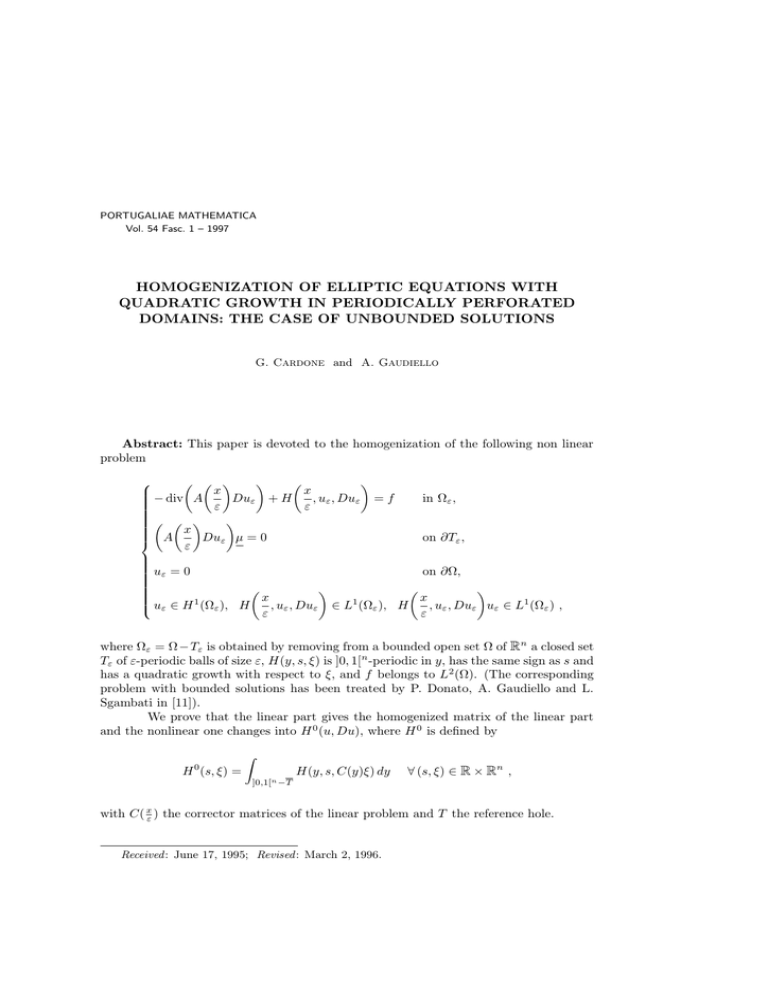
PORTUGALIAE MATHEMATICA
Vol. 54 Fasc. 1 – 1997
HOMOGENIZATION OF ELLIPTIC EQUATIONS WITH
QUADRATIC GROWTH IN PERIODICALLY PERFORATED
DOMAINS: THE CASE OF UNBOUNDED SOLUTIONS
G. Cardone and A. Gaudiello
Abstract: This paper is devoted to the homogenization of the following non linear
problem
µ µ ¶
¶
¶
µ
x
x
− div A
, uε , Duε = f
Duε + H
in Ωε ,
ε
ε
¶
µ µ ¶
x
on ∂Tε ,
Duε µ = 0
A
ε
uε = 0
on ∂Ω,
¶
µ
¶
µ
x
x
1
1
uε ∈ H (Ωε ), H
, uε , Duε ∈ L (Ωε ), H
, uε , Duε uε ∈ L1 (Ωε ) ,
ε
ε
where Ωε = Ω−Tε is obtained by removing from a bounded open set Ω of Rn a closed set
Tε of ε-periodic balls of size ε, H(y, s, ξ) is ]0, 1[n -periodic in y, has the same sign as s and
has a quadratic growth with respect to ξ, and f belongs to L2 (Ω). (The corresponding
problem with bounded solutions has been treated by P. Donato, A. Gaudiello and L.
Sgambati in [11]).
We prove that the linear part gives the homogenized matrix of the linear part
and the nonlinear one changes into H 0 (u, Du), where H 0 is defined by
0
H (s, ξ) =
Z
H(y, s, C(y)ξ) dy
]0,1[n −T
∀ (s, ξ) ∈ R × Rn ,
with C( xε ) the corrector matrices of the linear problem and T the reference hole.
Received : June 17, 1995; Revised : March 2, 1996.
52
G. CARDONE and A. GAUDIELLO
0 – Introduction
This paper is devoted to the study of the asymptotic behaviour, as ε tends to
zero, of the solutions uε of
(0.1)
µ µ ¶
¶
¶
µ
x
x
− div A
, uε , Duε = f
Duε + H
ε
ε
¶
µ µ ¶
x
Duε µ = 0
A
in Ωε ,
on ∂Tε ,
ε
on ∂Ω,
uε = 0
¶
µ
¶
µ
x
x
1
uε ∈ H 1 (Ωε ), H
, uε , Duε ∈ L (Ωε ), H
, uε , Duε uε ∈ L1 (Ωε ) ,
ε
ε
where Ω is a bounded open set of Rn , Ωε = Ω − Tε is a domain obtained
by removing from Ω a closed set Tε of ε-periodic balls of size ε, A(y) is a
]0, 1[n -periodic bounded definite positive matrix, H(y, s, ξ) is a Caratheodory
function defined on Rn × R × Rn , ]0, 1[n -periodic in y, with the same sign as s
(sign hypothesis) and with quadratic growth with respect to ξ (see assumptions
(1.7)–(1.10)), f belongs to L2 (Ω) and µ denotes the unitary external normal
vector with respect to Ωε .
The following main result is proved in Theorem 1.3 for a suitable class of
extension-operators {Pε }ε , up to a subsequence of {ε},
P ε uε * u
weakly in H01 (Ω)
as ε tends to zero, and
− div(A0 Du) + H 0 (u, Du) = θ f
in Ω ,
u ∈ H 1 (Ω), H 0 (u, Du) ∈ L1 (Ω), H 0 (u, Du)u ∈ L1 (Ω) ,
0
where − div(A0 Du) is the homogenized operator of the linear part and H 0 is
defined by
H 0 (s, ξ) =
Z
]0,1[n −T
H(y, s, C(y)ξ) dy
∀ (s, ξ) ∈ R × Rn ,
with C( ε· ) the corrector matrices of the linear problem, T ⊂⊂ ]0, 1[n the reference
hole and θ = |]0, 1[n −T |.
If the limit problem has a unique solution, then we need not pass to a subsequence of {ε}.
HOMOGENIZATION OF ELLIPTIC EQUATIONS
53
The general notion of H-convergence and correctors have been introduced by
F. Murat and L. Tartar in [13]. We refer also to [7] and [8] for the case of the
perforated domains.
The extension-operators have been introduced by D. Cioranescu and J. Saint
Jean Paulin in [9].
This paper is a sequel of [11]. In [11] the homogenization of a problem analogous to (0.1) is studied, but in the case where uε is bounded while no sign
condition is imposed on H. In the present paper we emphasize the main changes
and we refer to [11] for the remaining common parts.
The homogenization in a fixed domain of the nonlinear problem with quadratic
growth in the gradient was treated by A. Bensoussan, L. Boccardo, A. Dall’Aglio
and F. Murat in [2] both in the bounded case and in the unbounded case. Also
the homogenization of the nonlinear problem with subquadratic growth in the
gradient has been studied by L. Boccardo and T. Del Vecchio in [4] for a fixed
domain and by P. Donato and L. Sgambati in [12] for periodically perforated
domains.
Here we adapt some ideas introduced for a fixed domain in [2] and partially
developed for a perforated domain in [11]. The proof of the main result is based
on verifying that the correctors for the nonlinear problem are the same as for
corresponding linear problem.
We refer to [1], [3], [10] and [14] for a detailed bibliography on the homogenization theory.
Contents :
1. Position of the problem and the main result.
2. A corrector result.
3. Proof of Theorem 1.3.
1 – Position of the problem and the main result
Let Ω be an open bounded subset of Rn , n ≥ 2, with a smooth boundary ∂Ω,
Y = ]0, 1[n the reference cell, T ⊂⊂ Y an open subset with smooth boundary ∂T
and ε a parameter taking values in a decreasing positive sequence which tends to
zero.
Assume that for every ε there exists a subset Kε of Z n such that:
Ω∩
[
k∈Z n
ε(k + T ) =
[
k∈Kε
ε(k + T ) .
54
G. CARDONE and A. GAUDIELLO
Then, for every ε, we define the perforated domain Ωε by:
Tε =
[
ε(k + T ) ,
Ω ε = Ω − Tε
k∈Kε
and we introduce the space
n
Vε = v ∈ H 1 (Ωε ) : v|∂Ω = 0
o
equipped with the H 1 norm.
In the following we denote by
• χE the characteristic function of a subset E of Rn ,
• |E| the Lebesgue measure of a Lebesgue-measurable subset E of Rn ,
• ve or v ∼ the zero extension on Ω of every (vector) function v defined on Ωε ,
• µ the unitary external normal vector with respect to Y − T or Ωε according
to the situation.
Moreover we recall that
(1.1)
χΩε * θ = |Y − T |
in L∞ (Ω) weak*
as ε tends to zero.
We now introduce a sequence {Pε }ε of linear extension-operators such that
for every ε
(1.2)
Pε ∈ L(Vε , H01 (Ω)) ,
(Pε v)|Ω = v ∀ v ∈ Vε ,
ε
kD(Pε v)k(L2 (Ω))n ≤ ckDvk(L2 (Ωε ))n
∀ v ∈ Vε ,
where c is a constant independent of ε
and, for every g in H −1 (Ω), as in [12] we define Pε∗ g in Vε0 as follows:
(1.3)
Pε∗ g : v ∈ Vε → hg, Pε viH −1 (Ω),H 1 (Ω) ∈ Rn .
0
Remark 1.1. The existence of a sequence {Pε }ε satisfying (1.2) is proved
in [9]. Moreover (1.2) provides the Poincaré and Sobolev inequalities in Vε with
a constant independent of ε.
HOMOGENIZATION OF ELLIPTIC EQUATIONS
55
Let A(y) = (aij (y))ij be an n × n matrix-valued function defined on Rn such
that
(1.4)
2
A ∈ (L∞ (Rn ))n ,
A Y -periodic ,
n
X
aij (y) λi λj ≥ α|λ|2 ,
∃
α
>
0
:
y a.e. in Rn , ∀ λ ∈ Rn ,
i,j=1
and let us denote for every ε
Aε (x) = A
(1.5)
µ ¶
x
ε
a.e. in Rn .
Moreover let us give a Caratheodory function H defined on Rn × R × Rn such
that for y a.e. in Rn , for every s and s in R and for every ξ and ξ in Rn
(1.6)
|H(y, s, ξ)| ≤ b2 (|s|) (1 + |ξ|2 ) ,
(1.7)
|H(y, s, ξ) − H(y, s, ξ)| ≤ b1 (|s|) (1 + |ξ| + |ξ|) |ξ − ξ| ,
(1.8)
|H(y, s, ξ) − H(y, s, ξ)| ≤ b2 (|s − s|) (1 + |ξ|2 ) ,
(1.9)
H(x, s, ξ) s ≥ 0 ,
(1.10)
H(·, s, ξ) Y -periodic ,
where b1 and b2 are continuous increasing functions with b1 (0) ≥ 0 and b2 (0) = 0.
Remark 1.2. Observe that (1.6) follows from (1.8) and (1.9) by virtue of
the continuity of H(x, ·, ξ) in R.
For every ε, set
µ
¶
x
Hε (x, s, ξ) = H
, s, ξ ,
ε
(1.11)
x a.e. in Ωε , ∀ (s, ξ) ∈ R × Rn .
In this paper we study the asymptotic behaviour, as ε tends to zero, of the
solutions uε of the following problem:
(1.12)
Z
Ωε
Aε Duε Dv dx +
Z
Ωε
Hε (x, uε , Duε ) v dx =
Z
f v dx
Ωε
∀ v ∈ Vε ∩L∞ (Ωε ) ,
uε ∈ Vε , Hε (x, uε , Duε ) ∈ L1 (Ωε ), Hε (x, uε , Duε ) uε ∈ L1 (Ωε ) ,
with f in L2 (Ω).
56
G. CARDONE and A. GAUDIELLO
Following the same outline as [4] and [5], it is easy to prove that problem
(1.12) admits a solution uε . Moreover [6] shows that every solution of (1.12) can
be used as test function in (1.12). Then, taking v = uε in (1.12) and using (1.4)
and (1.9), we obtain the following a priori estimates:
(1.13)
Z
(1.14)
kuε kH 1 (Ωε ) ≤ c1 ,
Hε (x, uε , Duε ) uε dx ≤ c1 ,
Ωε
where c1 is a positive constant independent of ε.
As a consequence of (1.2) and (1.13) we deduce that, for some subsequence
(still denoted {ε}),
P u *u
ε ε
(1.15)
weakly in H01 (Ω) ,
P ε uε → u
strongly in L2 (Ω) ,
P ε uε → u
a.e. in Ω ,
as ε tends to zero.
To describe the problem satisfied by u, we use the n×n matrix-valued function
0
A = (a0ij )ij and C(y) = (cij (y))ij defined respectively by
(1.16)
a0ij =
Z
Y −T
aij (y) −
n
X
aik (y)
k=1
∂χj
∂yk
dy
and
(1.17)
cij (y) = δij −
∂χj
∂yi
a.e. in Y − T ,
in terms of the solution χj , j = 1, ..., n, of
(1.18)
³
´
− div A(y) D(yi − χj ) = 0
³
´
A(y) D(yi − χj ) · µ = 0
χ
Y -periodic ,
in Y − T ,
on ∂T ,
j
where A(y) = (aij (y))ij is given in (1.4).
Then we set
(1.19)
H 0 (s, ξ) =
Z
H(y, s, C(y)ξ) dy
Y −T
∀ (s, ξ) ∈ R × Rn ,
where H is the Caratheodory function satisfying (1.7)–(1.10).
HOMOGENIZATION OF ELLIPTIC EQUATIONS
57
Now we can state the main result of this paper.
Theorem 1.3. Let {Aε }ε be the sequence of n × n matrix-valued functions
defined by (1.5), {Hε }ε be the sequence of Caratheodory functions defined by
(1.11) under assumptions (1.7)–(1.10) and {uε }ε a sequence of solutions of (1.12).
Let {Pε }ε be a sequence of linear extension-operators satisfying (1.2), A0 be
the n×n matrix defined in (1.16), H 0 the function given in (1.19) and θ = |Y −T |.
Then there exists a subsequence (still denoted {ε}) and a function u in H01 (Ω)
such that, as ε tends to zero,
(1.20)
P ε uε * u
weakly in H01 (Ω) .
The function u satisfies the following:
(1.21)
Z
Z
Z
0
0
θ f v dx
H (u, Du) v dx =
A Du Dv dx +
Ω
Ω
Ω
∀ v ∈ H01 (Ω) ∩ L∞ (Ω) ,
u ∈ H01 (Ω), H 0 (u, Du) ∈ L1 (Ω), H 0 (u, Du) u ∈ L1 (Ω) ,
Z
Z
Z
A0 Du Du dx +
H 0 (u, Du) u dx =
θ f u dx .
Ω
Ω
Ω
Moreover, as ε tends to zero, the following convergences hold:
³
´
(1.22)
− div Aε (x) (Duε )∼ → − div(A0 Du)
(1.23)
Hε (x, uε , Duε )∼ * H 0 (u, Du)
strongly in H −1 (Ω) ,
weakly in L1 (Ω) .
The proof of Theorem 1.3 follows essentially the same outline as that of Theorem 1.3 in [11]. Consequently we shall give a detailed proof of the main changes
and refer to [11] for the remaining common parts.
Remark 1.4. The function
³
´
H(y, s, ξ) = h(y) + |ξ|2 g(s) ,
y a.e. in Rn , ∀ (s, ξ) ∈ R × Rn
with h a positive bounded measurable Y -periodic function and g an increasing
Lipschitz continuous function on R, such that g(0) = 0 (for example g(s) =
arctg(s)), satisfies assumptions (1.6)–(1.10). In this case
H 0 (s, ξ) = g(s)
Z
Y −T
³
´
h(y) + |C(y) ξ|2 dy
∀ (s, ξ) ∈ R × Rn .
58
G. CARDONE and A. GAUDIELLO
2 – A corrector result
In this Section we give a corrector result for problem (1.12).
Let C(y) be defined by (1.17). Then, for every ε, we set
C ε (x) = C
(2.1)
µ ¶
x
ε
a.e. in Ωε .
First we recall a result proved in [11] (Proposition 2.1 and Theorem 2.3).
Proposition 2.1 [11]. Let {Aε }ε be defined in (1.5), {Pε }ε satisfy (1.2),
{Pε∗ g}ε be defined in (1.3), for g in H −1 (Ω), and, for every ε, let wε be the
unique solution of the following linear problem:
´
³
ε (x) Dw
= Pε∗ g
−
div
A
ε
w =0
ε
´
³
Aε (x) Dw · µ = 0
ε
in Ωε ,
on ∂Ω,
on ∂Tε .
Moreover let A0 and {C ε }ε be defined in (1.16) and (2.1) respectively.
Then, as ε tends to zero, the following holds:
P ε wε * w
weakly in H01 (Ω) ,
lim sup kDwε − C ε φk(L2 (Ωε ))n ≤ ckDw − φk(L2 (Ω))n
ε→0
∀ φ ∈ (C0∞ (Ω))n ,
with c a constant independent of φ ,
where w is the unique solution of:
(
− div(A0 Dw) = g
in Ω,
w=0
on ∂Ω .
Moreover, if g is in W −1,∞ (Ω), then
Aε (Dwε )∼ (Dwε )∼ * A0 Dw Dw
weakly in L1 (Ω) ,
as ε tends to zero.
In the sequel we make use of the following known lemma:
HOMOGENIZATION OF ELLIPTIC EQUATIONS
59
Lemma 2.2. As ε tends to zero, let {gε }ε , be a sequence of functions
which converges weakly in L1 (Ω) to a function g0 and let {tε }ε be a sequence of
equibounded and measurable functions which converges almost everywhere in Ω
to a function t0 . Then
lim
Z
ε→0 Ω
gε tε dx =
Z
Ω
g0 t0 dx .
From now on, {ε} denotes a subsequence for which (1.15) holds.
Now we state the corrector result for problem (1.12).
Proposition 2.3. Under assumptions (1.4), (1.5), (1.8), (1.9), (1.10) and
(1.11), let {uε }ε be a subsequence of solutions of problem (1.12) for which convergence (1.15) holds, u be the function defined in (1.15) and {C ε }ε be defined
in (2.1).
Then
lim sup kDuε − C ε φk(L2 (Ωε ))n ≤ ckDu − φk(L2 (Ω))n
ε→0
∀ φ ∈ (C0∞ (Ω))n ,
where c is a constant independent of φ .
Proposition 2.3 is an immediate consequence of Proposition 2.1 and of the
following result.
Theorem 2.4. Under assumptions (1.4), (1.5), (1.8), (1.9), (1.10) and (1.11),
let {uε }ε be a subsequence of solutions of problem (1.12) for which convergence
(1.15) holds and let {vε }ε be the sequence of the solutions of the following linear
problem:
´
³
³
´
∗ − div(A0 Du)
ε (x) Dv
=
P
−
div
A
in Ωε ,
ε
ε
v =0
ε
³
´
Aε (x) Dv · µ = 0
ε
on ∂Ω,
on ∂Tε ,
with {Aε }ε defined in (1.5), {Pε }ε satisfying (1.2), A0 given in (1.16) and u
defined in (1.15).
Then
lim kD(uε − vε )k(L2 (Ωε ))n = 0 .
ε→0
Proof: The proof of this theorem follows the outline of the proof of Proposition 4.1 in [2], modified as follows due to the presence of holes.
60
G. CARDONE and A. GAUDIELLO
Let {uλ }λ∈N be a sequence in C0∞ (Ω) such that
(2.2)
strongly in H01 (Ω)
uλ → u
as λ → +∞
and let, for every λ in N, {vλ,ε }ε be the sequence of the solution of
(2.3)
´
³
´
³
∗ − div(A Du )
ε (x) Dv
=
P
−
div
A
0
λ
λ,ε
ε
vλ,ε = 0
³
Aε (x) Dv
λ,ε
´
µ=0
in Ωε ,
on ∂Ω,
on ∂Tε .
Then Proposition 2.1 implies that for every λ in N,
(2.4)
weakly in H01 (Ω) as ε → 0 .
Pε vλ,ε * uλ
Moreover it is easy to prove that (see proof of (3.6) in [11]), for every λ in N and
ε,
(2.5)
(
kDvλ,ε − Dvε k(L2 (Ωε ))n ≤ ckDuλ − Duk(L2 (Ω))n ,
where c is a constant independent of λ and ε .
Set
2
ϕµ : s ∈ R → s eµs ∈ R
with µ a positive parameter (depending on k) to be defined and for every k in
R+
n
o
Tk : s ∈ R → max −k, min{s, k} ∈ [−k, k] .
Then the function ϕµ (Tk (uε ) − Tk (vλ,ε )) belongs to Vε ∩ L∞ (Ωε ). Consequently,
if we choose ϕµ (Tk (uε ) − Tk (vλ,ε )) as test function in (1.12), we obtain, for every
λ in N and ε,
Z
Ωε
³
´
Aε Duε D ϕµ (Tk (uε ) − Tk (vλ,ε )) dx +
+
=
Z
Ωε
Z
Ωε
³
´
Hε (x, uε , Duε ) ϕµ Tk (uε ) − Tk (vλ,ε ) dx =
³
´
f ϕµ Tk (uε ) − Tk (vλ,ε ) dx ,
61
HOMOGENIZATION OF ELLIPTIC EQUATIONS
i.e.
Z
(2.6)
Ωε
³
´
³
³
Aε D Tk (uε ) − Tk (vλ,ε ) D ϕµ Tk (uε ) − Tk (vλ,ε )
+
−
+
+
Z
Z
Z
Z
Ωε
Ωε
Ωε
Ωε
³
³
Aε Dvλ,ε D ϕµ Tk (uε ) − Tk (vλ,ε )
³
´
³
³
´´
´´
dx +
´´
dx
dx
Aε D Gk (vλ,ε ) D ϕµ Tk (uε ) − Tk (vλ,ε )
³
´
³
³
Aε D Gk (uε ) D ϕµ Tk (uε ) − Tk (vλ,ε )
³
´
´´
dx
Hε (x, uε , Duε ) ϕµ Tk (uε ) − Tk (vλ,ε ) dx =
=
Z
Ωε
³
´
f ϕµ Tk (uε ) − Tk (vλ,ε ) dx ,
where Gk is the function defined by
Gk : s ∈ R → s − Tk (s) ∈ R .
Now we give an estimate from below for the left hand-side of (2.6).
Since ϕ0µ is a positive function, by virtue of (1.4) and for every ε, for every λ
in N and k in R+ we obtain the following estimate for the first term in the left
hand-side of (2.6):
Z
(2.7)
=
Z
Ωε
≥α
Z
Ωε
³
³
´
³
³
Aε D Tk (uε ) − Tk (vλ,ε ) D ϕµ Tk (uε ) − Tk (vλ,ε )
´
³
´
³
´´
dx =
´
Aε D Tk (uε ) − Tk (vλ,ε ) D Tk (uε ) − Tk (vλ,ε ) ϕ0µ Tk (uε ) − Tk (vλ,ε ) dx
Ωε
¯ ³
´¯2
³
´
¯
¯
¯D Tk (uε ) − Tk (vλ,ε ) ¯ ϕ0µ Tk (uε ) − Tk (vλ,ε ) dx .
If we choose ϕµ (Tk (uε ) − Tk (vλ,ε )) as test function in (2.3), for every ε, for
every λ in N and k in R+ we can rewrite the second term in the left hand-side of
(2.6) in the following way:
(2.8)
Z
Ωε
³
³
Aε Dvλ,ε D ϕµ Tk (uε ) − Tk (vλ,ε )
=
Z
Ω
³
´´
dx =
³
³
A0 Duλ D Pε ϕµ Tk (uε ) − Tk (vλ,ε )
´´´
dx .
62
G. CARDONE and A. GAUDIELLO
By the definition of Gk , the following equality for the third term in the left
hand-side of (2.6) holds for every ε, for every λ in N and k in R+ :
Z
Ωε
³
´
³
³
Aε D Gk (vλ,ε ) D ϕµ Tk (uε ) − Tk (vλ,ε )
=
Z
Ωε
³
´´
dx =
´
Aε Dvλ,ε Duε ϕ0µ Tk (uε ) − Tk (vλ,ε ) χ{|v
λ,ε |>k}
χ{|u
ε |<k}
dx .
Thus, by virtue of (1.2), (1.4) and (1.13), we deduce that, for every ε, for every
λ in N and k in R+ ,
(2.9)
¯Z
¯
¯
¯
³
ε
Ωε
´
³
³
A D Gk (vλ,ε ) D ϕµ Tk (uε ) − Tk (vλ,ε )
≤ c(µ, k) kDuε k(L2 (Ωε ))n
≤ c(µ, k) c1
Z
1³
α
Ω
³Z
Ωε
´´
|Dvλ,ε |2 χ{|v
¯
¯
dx¯¯ ≤
λ,ε
Aε (Dvλ,ε )∼ (Dvλ,ε )∼ χ{|P
χ
|>k} {|u
ε vλ,ε
ε
dx
|<k}
χ
|>k} {|P
ε uε
´1
2
dx
|<k}
´1
2
,
where c(µ, k) is a positive constant dependent only on µ and k.
The fourth term in the left hand-side of (2.6) can be treated similarly. Then
for every ε, for every λ in N and k in R+ , it results
¯Z
¯
¯
¯
(2.10)
ε
Ωε
³
´
³
³
A D Gk (uε ) D ϕµ Tk (uε ) − Tk (vλ,ε )
≤ c(µ, k)
c1 ³
α
Z
Ω
´´
Aε (Dvλ,ε )∼ (Dvλ,ε )∼ χ{|P
¯
¯
dx¯¯ ≤
ε uε
χ
|>k} {|P
ε vλ,ε
dx
|<k}
´1
2
.
Regarding the last term in the left hand-side of (2.6) we remark that, for every
ε, for every λ in N and k in R+ ,
Z
(2.11)
=
Z
{|uε |≤k}
+
Z
Ωε
³
´
Hε (x, uε , Duε ) ϕµ Tk (uε ) − Tk (vλ,ε ) dx =
³
´
Hε (x, uε , Duε ) ϕµ Tk (uε ) − Tk (vλ,ε ) dx
{|uε |>k}
³
´
2
Hε (x, uε , Duε ) Tk (uε ) − Tk (vλ,ε ) eµ(Tk (uε )−Tk (vλ,ε )) dx .
On the other hand, (1.9) implies that, for every ε, for every λ in N and k in R+ ,
(2.12)
Z
{|uε |>k}
³
´
2
Hε (x, uε , Duε ) Tk (uε ) − Tk (vλ,ε ) eµ(Tk (uε )−Tk (vλ,ε )) dx ≥ 0 .
63
HOMOGENIZATION OF ELLIPTIC EQUATIONS
Moreover from (1.2), (1.4) and (1.6) it follows that, for every ε, for every λ in N
and k in R+ ,
(2.13)
≤ b2 (k)
¯Z
¯
¯
¯
Z
≤ 2b2 (k)
{|uε |≤k}
Z
+ b2 (k)
≤ 2b2 (k)
{|uε |≤k}
Z
+ b2 (k)
³
{|uε |≤k}
Z
´
¯
¯
´¯
¯
³
´¯
¯
1 + |D(Tk (uε ))|2 ¯ϕµ Tk (uε ) − Tk (vλ,ε ) ¯ dx
¯ ³
´¯2 ¯ ³
´¯
¯
¯ ¯
¯
¯D Tk (uε ) − Tk (vλ,ε ) ¯ ¯ϕµ Tk (uε ) − Tk (vλ,ε ) ¯ dx
{|uε |≤k}
Ωε
Z
³
Hε (x, uε , Duε ) ϕµ Tk (uε ) − Tk (vλ,ε ) dx¯¯ ≤
³
´¯
¯
³
´¯
¯
1 + 2|Dvλ,ε |2 ¯ϕµ Tk (uε ) − Tk (vλ,ε ) ¯ dx
¯ ³
´¯2 ¯ ³
´¯
¯ ¯
¯
¯
¯D Tk (uε ) − Tk (vλ,ε ) ¯ ¯ϕµ Tk (uε ) − Tk (vλ,ε ) ¯ dx
Ω
1
+ 2b2 (k)
α
¯
¯
³
´¯
¯
χΩε ¯ϕµ Tk (Pε uε ) − Tk (Pε vλ,ε ) ¯ dx
Z
Ω
¯
¯
³
´¯
¯
Aε (Dvλ,ε )∼ (Dvλ,ε )∼ ¯ϕµ Tk (Pε uε ) − Tk (Pε vλ,ε ) ¯ dx .
Then from (2.11), (2.12) and (2.13) we deduce that, for every ε, for every λ in N
and k in R+ ,
Z
(2.14)
Ωε
³
´
Hε (x, uε , Duε ) ϕµ Tk (uε ) − Tk (vλ,ε ) dx ≥
≥ −2b2 (k)
− b2 (k)
Z
Z
− 2b2 (k)
Ωε
Ω
1
α
¯ ³
´¯2 ¯ ³
´¯
¯
¯ ¯
¯
¯D Tk (uε ) − Tk (vλ,ε ) ¯ ¯ϕµ Tk (uε ) − Tk (vλ,ε ) ¯ dx
¯
¯
³
´¯
¯
χΩε ¯ϕµ Tk (Pε uε ) − Tk (Pε vλ,ε ) ¯ dx
Z
Ω
¯
¯
³
´¯
¯
Aε (Dvλ,ε )∼ (Dvλ,ε )∼ ¯ϕµ Tk (Pε uε ) − Tk (Pε vλ,ε ) ¯ dx .
Now, combining (2.6) with (2.7), (2.8), (2.9), (2.10) and (2.14) we obtain, for
every ε, for every λ in N and k in R+ ,
α
Z
Ωε
¯ ³
´¯2
³
´
¯
¯
¯D Tk (uε ) − Tk (vλ,ε ) ¯ ϕ0µ Tk (uε ) − Tk (vλ,ε ) dx +
+
Z
Ω
³
³
³
A0 Duλ D Pε ϕµ Tk (uε ) − Tk (vλ,ε )
´´´
dx −
64
G. CARDONE and A. GAUDIELLO
c1 ³
α
− c(µ, k)
− c(µ, k)
− 2b2 (k)
− b2 (k)
c1 ³
α
Z
Z
Ωε
Ω
1
− 2b2 (k)
α
Z
Z
Ω
Aε (Dvλ,ε )∼ (Dvλ,ε )∼ χ{|P
Ω
Aε (Dvλ,ε )∼ (Dvλ,ε )∼ χ{|P
ε vλ,ε
ε uε
χ
|>k} {|P
χ
|>k} {|P
´1
2
ε uε |<k}
´1
2
ε vλ,ε |<k}
¯ ³
´¯2 ¯ ³
´¯
¯
¯ ¯
¯
¯D Tk (uε ) − Tk (vλ,ε ) ¯ ¯ϕµ Tk (uε ) − Tk (vλ,ε ) ¯ dx
¯
¯
³
´¯
¯
χΩε ¯ϕµ Tk (Pε uε ) − Tk (Pε vλ,ε ) ¯ dx
Z
Ω
¯
¯
³
´¯
¯
Aε (Dvλ,ε )∼ (Dvλ,ε )∼ ¯ϕµ Tk (Pε uε ) − Tk (Pε vλ,ε ) ¯ dx ≤
≤
Z
Ω
³
´
f ϕµ Tk (Pε uε ) − Tk (Pε vλ,ε ) χΩε dx ,
from which, choosing µ (depending on k) such that
α ϕ0µ (s) − 2b2 (k) |ϕµ (s)| ≥
α
2
∀s ∈ R ,
it follows that, for every ε, for every λ in N and k in R+ ,
(2.15)
° ³
´°2
°
°
°D Tk (uε ) − Tk (vλ,ε ) °
(L2 (Ωε ))n
2
−
α
+
Z
Ω
³
³
A0 Duλ D Pε ϕµ Tk (uε ) − Tk (vλ,ε )
2c(k) c1 ³
α2
2c(k) c1 ³
+
α2
+
³
≤
2b2 (k)
α
Z
Z
Z
Z
Ω
Ω
Aε (Dvλ,ε )∼ (Dvλ,ε )∼ χ{|P
Ω
Aε (Dvλ,ε )∼ (Dvλ,ε )∼ χ{|P
¯
¯
³
³
´´´
ε vλ,ε
ε uε
χΩε ¯Pε ϕµ Tk (uε ) − Tk (vλ,ε )
dx
χ
|>k} {|P
χ
|>k} {|P
´´¯
¯
¯ dx
´1
2
ε uε |<k}
´1
2
ε vλ,ε |<k}
¯ ³
´¯
4b2 (k)
¯
ε
∼
∼¯
T
(P
u
)
−
T
(P
v
)
A
(Dv
)
(Dv
)
ϕ
¯ dx
¯
ε
ε
ε
µ
k
k
λ,ε
λ,ε
λ,ε
α2
Ω
Z
´´
³ ³
2
+
f Pε ϕµ Tk (uε ) − Tk (vλ,ε ) χΩε dx ,
α Ω
+
where, now, c(k) is a constant dependent only on k.
In order to pass to the limit, as ε tends to zero, in (2.15), we make some
remarks.
Making use of (1.1), (1.2), (1.15) and (2.4) it is easy to prove that (cf. (3.17)
65
HOMOGENIZATION OF ELLIPTIC EQUATIONS
in [9]), passing possibly to a subsequence of {ε}, for every λ in N and k in R+ ,
(2.16)
´´
³
´
³ ³
P
ϕ
T
(u
)
−
T
(v
)
→
ϕ
T
(u)
−
T
(u
)
,
ε
µ
ε
µ
k
k
λ,ε
k
k
λ
³
³
´
´
ϕµ Tk (Pε uε ) − Tk (Pε vλ,ε ) → ϕµ Tk (u) − Tk (uλ ) ,
1
2
weakly in H0 (Ω), strongly in L (Ω) and a.e. in Ω ,
as ε tends to zero.
Moreover, from Proposition 2.1, it follows that, for λ in N
Aε (Dvλ,ε )∼ (Dvλ,ε )∼ * A0 Duλ Duλ
(2.17)
weakly in L1 (Ω) ,
as ε tends to zero.
Furthermore, if we set
¯
¯
n
¯
¯
o
¯
¯
n
¯
¯
o
A = k ∈ R+ : ∃ λ : ¯{|uλ | = k}¯ 6= 0 ∪ k ∈ R+ : ¯{|u| = k}¯ 6= 0 ,
from (1.15) and (2.4) we deduce that, passing possibly to a subsequence of {ε},
for every λ in N and for k in R+ − A,
(2.18)
χ{|Pε vλ,ε |>k} χ{|Pε uε |<k} → χ{|uλ |>k} χ{|u|<k}
χ
{|Pε uε
χ
|>k} {|P
ε vλ,ε |<k}
→ χ{|u|>k} χ{|u
a.e. in Ω
λ |<k}
as ε tends to zero.
Observe that, since λ takes values in a sequence and uλ and u are in L1 (Ω),
it results that |A| = 0. Consequently (2.18) holds for a.e. k in R+ .
Then passing to the limit, as ε tends to zero, in (2.15) and making use of
(1.1), (2.16), (2.17), (2.18) and Lemma 2.2, we obtain, for every λ in N and for
a.e. k in R+ ,
(2.19)
° ³
°
´°2
°
lim sup°D Tk (uε ) − Tk (vλ,ε ) °
ε→0
≤−
+
2
α
Z
Ω
(L2 (Ωε ))n
³
≤
³
A0 Duλ D ϕµ Tk (u) − Tk (uλ )
2c(k) c1 ³
α2
Z
Ω
A0 Duλ Duλ χ{|u
λ
´´
dx
χ
dx
|>k} {|u|<k}
´1
2
+
66
G. CARDONE and A. GAUDIELLO
+
2c(k) c1 ³
α2
2b2 (k)
+
α
Z
Z
Z
Ω
Ω
A0 Duλ Duλ χ{|u|>k} χ{|u
¯
¯
³
λ
dx
|<k}
´¯
¯
´1
2
θ¯ϕµ Tk (u) − Tk (uλ ) ¯ dx
¯ ³
´¯
4b2 (k)
¯
¯
0
T
(u)
−
T
(u
)
ϕ
A
Du
Du
¯ dx
¯
µ
k
k
λ
λ
λ
2
α
Ω
Z
³
´
2
f ϕµ Tk (u) − Tk (uλ ) θ dx ,
+
α Ω
+
where c(k) is a constant dependent on k only.
Now we prove that for every λ in N and k in R+
(2.20)
ε→0
and
(2.21)
°
°
°2
°
lim sup°D(Gk (uε ))°
°
°
(L2 (Ωε ))n
°2
°
lim sup°D(Gk (vλ,ε ))°
ε→0
≤
(L2 (Ωε ))n
1
α
≤
Z
1
α
Ω
Z
f θ Gk (u) dx
Ω
A0 Duλ Gk (uλ ) dx .
Fix k and choose v = Tn (Gk (uε )), n ∈ N, as test function in (1.12). Then
from (1.2) and (1.9) it follows that
Z
(2.22)
ε
Ωε
³
´
A Duε D Tn (Gk (uε )) dx ≤
Z
Ω
f Tn (Gk (Pε uε )) χΩε dx .
Passing to the limit, as n → +∞, in (2.22), by virtue of definition of Gk and
(1.4) it results
α
Z
Z
¯
¯2
¯
¯
Aε D(Gk (uε )) D(Gk (uε )) dx
¯D(Gk (uε ))¯ dx ≤
Ωε
Ωε
Z
=
(2.23)
≤
Z
Ωε
Ω
Aε Duε D(Gk (uε )) dx
f (Gk (Pε uε )) χΩε dx .
Then passing to the limit, as ε tends to zero, in (2.23), by (1.1) and (1.15) we
obtain (2.20).
To prove (2.21) fix k and choose Gk (vλ,ε ) as test function in (2.3). Then, by
definition of Gk and (1.4) it follows
α
Z
Z
¯
¯2
¯
¯
Aε D(Gk (vλ,ε )) D(Gk (vλ,ε )) dx
¯D(Gk (vλ,ε ))¯ dx ≤
Ωε
ZΩε
=
=
Z
Ωε
Ω
Aε Dvλ,ε D(Gk (vλ,ε )) dx
³
´
A0 Duλ D Pε (Gk (vλ,ε )) dx
67
HOMOGENIZATION OF ELLIPTIC EQUATIONS
from which passing to the limit, as ε tends to zero, by virtue of (1.2) and (2.4)
we obtain (2.21).
Now combining (2.5) with (2.19), (2.20) and (2.21) it follows that for every λ
in N and for a.e. k in R+
lim sup kDuε − Dvε k2(L2 (Ωε ))n ≤
(2.24)
ε→0
°
°2
°
°
≤ 2 lim sup°Dvε − Dvλ,ε °
(L2 (Ωε ))n
ε→0
°
°
°2
°
≤ 2c°Duλ − Du°
(L2 (Ω))n
(L2 (Ω))n
+
16c(k) c1 ³
α2
16c(k) c1 ³
+
α2
16b2 (k)
+
α
ε→0
Z
Z
Z
Z
Ω
° ³
°
ε→0
(L2 (Ωε ))n
ε→0
−
16
α
Z
Ω
´°2
°
³
³
A0 Duλ D ϕµ Tk (u) − Tk (uλ )
Ω
A0 Duλ Duλ χ{|u|>k} χ{|u
λ
χ
dx
|>k} {|u|<k}
´¯
¯
λ
dx
|<k}
´1
2
´1
2
θ¯ϕµ Tk (u) − Tk (uλ ) ¯ dx
¯ ³
´¯
32b2 (k)
¯
¯
0
T
(u)
−
T
(u
)
ϕ
A
Du
Du
¯ dx
¯
µ
k
k
λ
λ
λ
2
α
Ω
Z
Z
³
´
16
8
f ϕµ Tk (u) − Tk (uλ ) θ dx +
f θ Gk (u) dx
+
α Ω
α Ω
Z
4
+
A0 Duλ D(Gk (uλ )) dx ,
α Ω
+
where c(k) is a constant dependent only on k.
Observe, now, that, by virtue of (2.2), for a.e. k in (0, +∞)
(2.25)
´
³
ϕ
T
(u)
−
T
(u
)
*0
µ
k
k
λ
¯ ³
´¯
¯
¯
¯ϕ T (u) − Tk (uλ ) ¯ * 0
µ k
χ{|u |>k} χ{|u|<k} * 0
λ
χ
χ
*0
{|u|>k} {|uλ |<k}
Gk (uλ ) * Gk (u)
as λ tends to infinity.
(L2 (Ωε ))n
(L2 (Ωε ))n
ε→0
Ω
³
(L2 (Ωε ))n
° ³
´°2
°
°
+ 4 lim sup°D Gk (vλ,ε ) °
A0 Duλ Duλ χ{|u
¯
¯
°2
°
+ 8 lim sup°D Tk (uε ) − Tk (vλ,ε ) °
°2
°
°
°
+ 8 lim sup°D(Gk (uε ))°
°
°2
°
°
≤ 2c°Duλ − Du°
°
°
+ 2 lim sup°Dvλ,ε − Duε °
weakly in H01 (Ω),
weakly* in L∞ (Ω),
weakly* in L∞ (Ω),
weakly* in L∞ (Ω),
weakly in H01 (Ω) ,
´´
dx
68
G. CARDONE and A. GAUDIELLO
Then passing to the limit, as λ tends to infinity, in (2.24) and making use of
(2.2) and (2.25) we have that for a.e. k in R+ ,
(2.26)
°
°
°2
°
lim sup°Duε − Dvε °
ε→0
(L2 (Ωε ))n
≤
8
α
Z
Ω
≤
f θ Gk (u) dx +
4
α
Z
Ω
A0 Du D(Gk (u)) dx .
Finally passing to the limit, as k tends to infinity, in (2.26) we obtain the desired
result.
The following result is an immediate consequence of Proposition 2.6 in [9].
Proposition 2.5. Let {Hε }ε be the sequence of Caratheodory functions
defined by (1.11) under assumptions (1.7)–(1.10), H 0 be the function given in
(1.19) and let {C ε }ε be defined by (2.1) under assumption (1.4).
Then H 0 satisfies (1.7)–(1.9) (up to a multiplicative constant β) and
Hε (x, Tk ϕε , C ε φ)∼ * H 0 (Tk ϕ0 , φ)
weakly in L1 (Ω)
as ε tends to zero, for k in R+ , for φ in (C0∞ (Ω))n and for sequence {ϕε }ε of
measurable functions on Ω such that
ϕε → ϕ 0
where
a.e. in Ω ,
n
o
Tk : s ∈ R → max −k, min{s, k} .
3 – Proof of Theorem 1.3
Let {ε} be a subsequence for which (1.15) holds and let u and H 0 be defined
by (1.15) and (1.19) respectively.
From (1.15) and Proposition 2.5 it follows that, for k in R+
(3.1)
³
Hε x, Tk (Pε uε ), C ε φ
´∼
* H 0 (Tk u, φ)
weakly in L1 (Ω)
as ε tends to zero, for φ in (C0∞ (Ω))n .
Let us prove that, for k in R+ ,
(3.2)
³
Hε x, Tk (Pε uε ), Duε
as ε tends to zero.
´∼
* H 0 (Tk u, Du)
weakly in L1 (Ω)
69
HOMOGENIZATION OF ELLIPTIC EQUATIONS
Let {φh }h∈N be a sequence in (C0∞ (Ω))n such that
(3.3)
strongly in (L2 (Ω))n .
φh → Du
Fix k in R+ . Then (1.7) and Proposition 2.5 imply that, for ϕ in L∞ (Ω),
(3.4)
¯
¯Z µ ³
³
´¶
´∼
¯
¯
0
¯
Hε x, Tk (Pε uε ), Duε − H Tk (u), Du ϕ dx¯¯ ≤
¯
Ω
Z ¯
¯
¯
¯
≤
¯Hε (x, Tk uε , Duε ) − Hε (x, Tk uε , C ε φh )¯ |ϕ| dx
Ωε
¯
¯Z µ ³
¶
´∼
¯
¯
ε
0
¯
Hε x, Tk (Pε uε ), C φh − H (Tk u, φh ) ϕ dx¯¯
+¯
Ω
Z ¯
¯
¯
¯
+ ¯H 0 (Tk u, φh ) − H 0 (Tk u, Du)¯ |ϕ| dx
Ω
≤ b1 (k)
Z
Ωε
³
´
1 + |Duε | + |C ε φh | |Duε − C ε φh | |ϕ| dx
¯
¯Z µ ³
¶
´∼
¯
¯
0
ε
¯
Hε x, Tk (Pε uε ), C φh − H (Tk u, φh ) ϕ dx¯¯
+¯
Ω
Z ³
´
+ β b1 (k)
Ω
1 + |φh | + |Du| |φh − Du| |ϕ| dx ,
for every ε and h. Moreover from (1.13) and Proposition 2.3 it follows that
(3.5)
lim sup
ε→0
Z
Ωε
³
´
1 + |Duε | + |C ε φh | |Duε − C ε φh | |ϕ| dx ≤
≤ lim sup
ε→0
Z
Ωε
³
´
1 + 2|Duε | + |C ε φh − Duε | |Duε − C ε φh | |ϕ| dx
µ°
°
°
°
≤ c lim sup °Duε − C ε φh °
ε→0
µ°
°
°
°
≤ c °Du − φh °
(L2 (Ω))n
(L2 (Ωε ))n
°
°
°2
°
+ °Duε − C ε φh °
°2
°
°
°
+ °Du − φh °
(L2 (Ω))n
¶
,
(L2 (Ωε ))n
where c is a constant independent of h.
Then from (1.15), Proposition 2.5, (3.3), (3.4) and (3.5) we obtain (3.2).
Now we prove that
(3.6)
H 0 (u, Du) ∈ L1 (Ω) ,
H 0 (u, Du) u ∈ L1 (Ω) .
¶
70
G. CARDONE and A. GAUDIELLO
By virtue of (1.9) and (1.14) it results that, for every ε and for every k in R + ,
Z
(3.7)
Ω
³
Hε x, Tk (Pε uε ), Duε
´∼
=
≤
Tk (Pε uε ) χ{|P
Z
Z
{|Pε uε |<k}
Ω
ε uε |<k}
dx =
Hε (x, Pε uε , Duε )∼ Pε uε dx
Hε (x, Pε uε , Duε )∼ Pε uε dx ≤ c1 .
On the other hand, from (1.15) it follows that, passing possibly to a subsequence
of {ε}, for a.e. k in R+ ,
(3.8)
χ{|P
(3.9)
Tk (Pε uε ) → Tk (u)
ε uε |<k}
→ χ{|u|<k}
a.e. in Ω ,
a.e. in Ω ,
as ε tends to zero.
Then passing to the limit, as ε tends to zero, in (3.7) and making use of (3.2),
(3.8), (3.9) and Lemma 2.2 we have that, for a.e. k in R+ ,
(3.10)
Z
Ω
H 0 (u, Du) u χ{|u|<k} dx =
Z
Ω
H 0 (Tk u, Du) Tk u χ{|u|<k} dx ≤ c1 .
Passing to the limit in (3.10) as k goes to infinity, by virtue of sign property for
H 0 and of Beppo Levi’s Theorem, we deduce that
H 0 (u, Du) u ∈ L1 (Ω) ,
(3.11)
Z
Ω
H 0 (u, Du) u dx ≤ c1 .
Moreover, for k fixed we have
¯
¯
¯ ¯¯
¯
1 0
¯ 0
¯ ¯ 0
¯
H
(u,
Du)
=
H
(u,
Du)
χ
+
H
(u,
Du)
u
χ
¯
¯ ¯
{|u|<k}
{|u|≥k} ¯
u
¯
¯ 1
¯
¯
≤ ¯H 0 (Tk u, Du) χ{|u|<k} ¯ + H 0 (u, Du) u ,
k
which, by virtue of (3.2) and (3.11), implies
H 0 (u, Du) ∈ L1 (Ω) .
So we have obtained (3.6). Now we prove (1.23).
At first let us observe that for ε and for φ in L∞ (Ω),
(3.12)
=
Z
{|Pε uε |<k}
³
Z
Ω
Hε (x, Pε uε , Duε )∼ φ dx =
Hε x, Tk (Pε uε ), Duε
´∼
φ dx +
Z
{|Pε uε |≥k}
Hε (x, Pε uε , Duε )∼ φ dx ,
71
HOMOGENIZATION OF ELLIPTIC EQUATIONS
(3.13)
Z
0
H (u, Du) φ dx =
Ω
Z
0
{|u|<k}
H (Tk u, Du) φ dx +
Z
H 0 (u, Du) φ dx .
{|u|≥k}
On the other hand from (3.2), (3.8) and Lemma 2.2, we deduce that, for a.e. k
in R+ ,
(3.14)
lim
Z
ε→0 {|Pε uε |<k}
³
Hε x, Tk (Pε uε ), Duε
´∼
φ dx =
Z
{|u|<k}
H 0 (Tk u, Du) φ dx .
Moreover (3.6) implies that
(3.15)
lim
Z
k→+∞ {|u|≥k}
H 0 (u, Du) φ dx = 0
whereas (1.9) and (1.14) imply that, for every ε and k,
Z
(3.16)
{|Pε uε |≥k}
¯
¯
c1
¯
¯
.
¯Hε (x, Pε uε , Duε )∼ ¯ dx ≤
k
Then combining (3.12) with (3.13), (3.14), (3.15) and (3.16) we obtain (1.23).
To prove (1.22) observe that, for every ε,
(3.17)
³
´
³
´
³
− div Aε (Duε )∼ = − div Aε (Duε − Dvε )∼ + − div(Aε (Dvε ))∼
³
´
³
´
− Pε∗ − div(A0 Du) + Pε∗ − div(A0 Du) ,
´
where vε is the solution of the auxiliary problem given in Theorem 2.4. By virtue
of Theorem 2.4 the first term in the right hand-side of (3.17) converges to zero
strongly in H −1 (Ω), as ε tends to zero. Note also that, from the definition of Vε ,
the second term in the right hand-side of (3.17) is zero. Consequently, since the
last term in the right hand-side of (3.17) converges to − div(A0 Du) strongly in
H −1 (Ω) as ε tends to zero (see [11]), (1.22) holds.
Finally combining (1.22) with (1.23), (1.1) and by virtue of [6] we have that
u is a solution of (1.21).
REFERENCES
[1] Attouch, H. – Variational convergence for functions and operators, Applicable
Mathematics Series, Pitman, London, 1984.
[2] Bensoussan, A., Boccardo, L., Dall’Aglio, A. and Murat, F. – H-convergence for quasi-linear elliptic equations under natural hypotheses on the correctors,
Proceedings of the conference “Composite media and homogenization theory” held
in Trieste, September, 1993.
72
G. CARDONE and A. GAUDIELLO
[3] Bensoussan, A., Lions, J.P. and Papanicolaou, G. – Asymptotic analysis for
periodic structures, North Holland, Amsterdam, 1978.
[4] Boccardo, L. and Del Vecchio, T. – Homogenization of strongly nonlinear equations with gradient dependent lower order nonlinearity, Asymp. Anal.,
5 (1991), 75–90.
[5] Boccardo, L., Murat, F. and Puel, J.-P. – Existence de solutions non bornées
pour certaines équations quasi-lineaires, Portugaliae Math., 41 (1982), 507–534.
[6] Brezis, H. and Browder, F.E. – Some properties of higher order Sobolev spaces,
J. Math. Pures Appl., 61 (1982), 245–259.
[7] Briane, M., Damlamian, A. and Donato, P. – H-convergence for perforated
domains, Collége de France Seminar (Brezis & J.L. Lions, eds.), Research Notes in
Mathematics, Longman, London, to appear.
[8] Cioranescu, D. and Murat, F. – Un terme étrange venu d’ailleurs, Nonlinear
Partial Differenzial Equations and their Applications, Collége de France Seminar,
Vol. II and III (Brezis & J.L. Lions, eds.), Research Notes in Mathematics 60 &
70, Pitman, London (1982), p.98–138 & p.154–178.
[9] Cioranescu, D. and Saint Jean Paulin, J. – Homogenization in open sets
with holes, J. Math. Anal. and Appl., 71 (1979), 590–607.
[10] Dal Maso, G. – An introduction to Γ-convergence, Birkhäuser, Boston, 1993.
[11] Donato, P., Gaudiello, A. and Sgambati, L. – Homogenization of bounded
solutions of elliptic equations with quadratic growth in periodically perforated domains, Preprint of the Laboratoire d’Analyse Numérique of the University Paris
VI, n.R94030, 1995. Asymptotic Analysis, to appear.
[12] Donato, P. and Sgambati, L. – Homogenization of some nonlinear problems in
perforated domains, Revista de Matemáticas Aplicadas, 15(1) (1994), 17–38.
[13] Tartar, L. – Cours Peccot, Collége de France (March 1977). Partially written in
F. Murat, “H-convergence”, Séminaire d’Analyse Fonctionnelle et Numérique de
l’Université d’Alger (1977-78). English translation in “Mathematical Modelling of
Composite Materials” (R.V. Kohn, ed.), Progress in Nonlinear Differential Equations and their Applications, Birkhäuser, Boston, 1994.
[14] Sanchez-Palencia, E. – Non-homogeneous media and vibration theory, Lecture
Notes in Physics 127, Springer, Berlin, 1980.
Giuseppe Cardone,
Università di Napoli “Federico II”, Dip. di Mat. e Appl. “R. Caccioppoli”,
Complesso Monte S. Angelo, Edificio T, 80125 Napoli, via Cintia – ITALIA
and
Antonio Gaudiello,
Università di Napoli “Federico II”, Facoltà di Agraria, Istituto di Idraulica Agraria,
Via Università, n. 100, 80055 Portici (NA),
and
Università di Napoli “Federico II”, Dip. di Mat. e Appl. “R. Caccioppoli”,
Complesso Monte S. Angelo, Edificio T, 80125 Napoli, via Cintia – ITALIA
